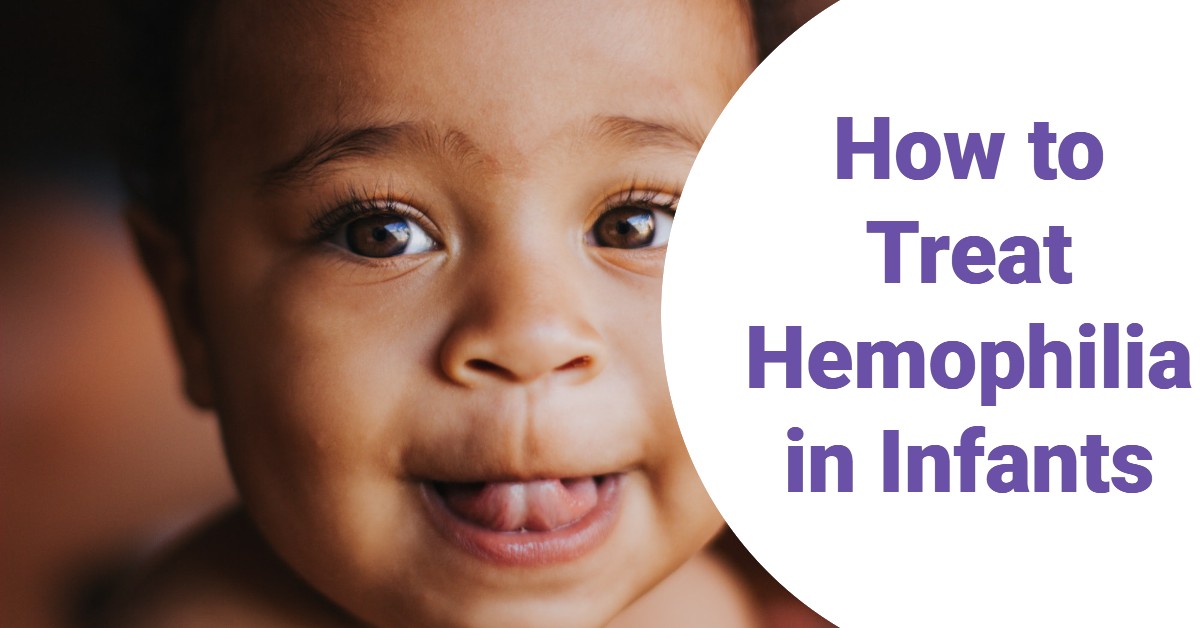How to Treat Hemophilia in Infants

How to Treat Hemophilia in Infants: Imagine a world where a simple cut or bruise could be life-threatening for an infant. This is the reality for those with hemophilia, a genetic bleeding disorder that affects the blood’s ability to clot properly. However, with modern medicine and advanced treatments, infants with hemophilia can live healthy and active lives.

In this article, we’ll explore how medical professionals treat hemophilia in infants, using innovative therapies to prevent bleeding episodes and manage the disorder when it occurs. So let’s dive into the world of hemophilia and discover the incredible ways doctors and caregivers are helping infants overcome this challenging condition.
How to Treat Hemophilia in Infants: FAQs & Answers
Can children with hemophilia participate in physical activities and sports?
Yes, with proper management and precautions, children with hemophilia can participate in physical activities and sports. However, it is important for them to wear protective gear, avoid high-risk activities, and have access to emergency medical care if needed.
What are some complications of hemophilia in children?
Complications of hemophilia in children may include joint damage, chronic pain, infections, and developmental delays. Regular monitoring and management can help prevent or minimize these complications.
Are there any new treatments or therapies being developed for hemophilia in children?
Yes, there are ongoing research and development of new treatments and therapies for hemophilia, including gene therapy, which involves replacing or repairing the defective gene that causes hemophilia. These treatments show promising results and may provide a potential cure for hemophilia in the future.
What is hemophilia?
Hemophilia is a rare genetic bleeding disorder that affects the blood’s ability to clot properly. It is caused by a deficiency in one of the blood clotting factors, specifically clotting factor VIII (hemophilia A) or clotting factor IX (hemophilia B). Hemophilia primarily affects males, but females can also be carriers of the condition.
People with hemophilia may experience excessive bleeding and difficulty in clotting after an injury or surgery. They may also experience spontaneous bleeding episodes in joints, muscles, and other organs. The severity of hemophilia can vary depending on the level of clotting factor present in the blood.
There is currently no cure for hemophilia, but it can be managed with treatment. Clotting factor replacement therapy is the primary treatment for hemophilia, which involves infusing clotting factor concentrates into the bloodstream to replace the deficient clotting factor. Other treatments may include prophylaxis, which involves administering regular doses of clotting factors to prevent bleeding, and on-demand therapy, which involves administering clotting factors as needed when a bleeding episode occurs.
Types of Hemophilia
The three primary types of hemophilia are as follows:
Hemophilia type A. The absence of the blood clotting factor VIII is the root cause of this. About 90% of haemophiliacs have type A illness. This condition is also known as typical haemophilia or factor VIII deficiency.
Hemophilia type B. Factor IX insufficiency is the root cause of this. Christmas illness and factor IX deficiency are other names for this condition.
Hemophilia type C. This phrase is sometimes used by medical professionals to describe a deficiency in clotting factor XI.
What causes hemophilia in children?
Types A and B hemophilia are hereditary illnesses. They are transmitted from parents to offspring via an X-chromosome gene. Males have one X and one Y chromosome, whereas females have two X chromosomes.
The hemophilia gene is located on an X chromosome in a female carrier. There is a 50/50 probability that the hemophilia gene will be transferred to the unborn child when a female hemophilia carrier becomes pregnant.
- Sons who inherit the gene will develop the condition.
- A daughter who receives the gene will be a carrier.
None of the males will develop hemophilia if the mother does not have the gene, while all of the girls will be carriers if the father has the condition.
There is no known family history of hemophilia in around one-third of children who have the condition. In some situations, it is thought that a novel gene fault may be responsible for the condition.
Even though they frequently have normal amounts of clotting factors, those with hemophilia may be:
- Easily Bruised
- Increase bleeding by Surgery and dental procedures
- Bleed from the nose frequently
- Bleed profusely with your period
Normal bleeding is unaffected by hemophilia C, although, following surgery, there may be increased bleeding.
What are the symptoms of hemophilia?
Heavy, uncontrolled bleeding is this disorder’s most common symptom.
The quantity of clotting components in the blood affects how severe hemophilia is. When having major operations or teeth extractions, those with hemophilia who have levels higher than 5% (100% being the average for unaffected children) seldom experience bleeding. These kids might not even be identified until there are surgical-related bleeding issues.
When the factor VIII or IX level is under 1%, hemophilia is considered severe. Even the most routine everyday tasks might cause bleeding in young kids. Bleeding might sometimes happen without any obvious wounds. The joints and the brain are where bleeding happens most frequently.
BruisingEven minor incidents might result in bruises. As a result, there may be a significant accumulation of blood under the skin that causes swelling (hematoma). Due to this, most kids receive their first diagnosis between the ages of 12 and 18 months. The youngster is more animated at this time.
Easy to bleed
a propensity for slight injuries to cause bleeding from the gums, nose, and mouth. Haemophilia is frequently indicated by bleeding while cleaning teeth or having dental procedures done.
A joint is bleeding
If left untreated, hemarthrosis (bleeding into a joint) can result in discomfort, immobility, and deformity. The most frequent location for problems from hemophilia bleeding is here. With repeated occurrences, this joint bleeding can cause severe, agonizing, chronic arthritis, deformity, and deformity.
Blood entering the muscles
Swelling, discomfort, and redness can result from bleeding into the muscles. The area’s tissues and nerves may become more compressed due to swelling brought on by an abundance of blood in these places. Deformity and lasting harm may result from this.
Bleeding in the brain due to trauma or naturally
The most frequent and dangerous bleeding consequence in children with hemophilia is bleeding after an accident or spontaneously in the brain. Even a little hit on the head or a fall can cause bleeding in or around the brain. Blindness, intellectual impairment, and a range of neurological disorders can be brought on by small brain bleeds. If it is not identified and treated quickly away, it can be fatal.
Other causes of bleeding
Blood in the stool or urine is another symptom of hemophilia.
How to Treat Hemophilia In Children
The treatment for hemophilia in infants is aimed at preventing bleeding episodes and managing bleeding when it occurs. Here are some ways to treat hemophilia in infants:
1. Clotting factor replacement therapy
The primary treatment for hemophilia is to replace the deficient clotting factor with clotting factor concentrates. This is typically administered through intravenous (IV) infusion. The frequency and dosage of these infusions will depend on the severity of hemophilia and the individual needs of the patient.
2. Prophylaxis
Prophylaxis involves administering regular doses of clotting factors to prevent bleeding. This is typically recommended for infants with severe hemophilia to prevent joint damage and other complications.
3. On-demand therapy
On-demand therapy involves administering clotting factors as needed when a bleeding episode occurs. This is typically recommended for infants with mild to moderate hemophilia.
4. Avoiding injuries
It is important for infants with hemophilia to avoid injuries that could cause bleeding. Parents and caregivers should take steps to prevent accidents and injuries, such as padding sharp corners, using safety gates, and closely supervising infants during playtime.
5. Comprehensive care
Infants with hemophilia should receive comprehensive care from a team of healthcare providers, including a hematologist, pediatrician, and specialized hemophilia treatment center. This can help ensure that the infant’s treatment plan is properly managed and adjusted as needed.
With proper treatment and management, infants with hemophilia can lead healthy and active lives.
Get in touch with your child’s doctor.
- Unusual or excessive bleeding, such as nosebleeds or bleeding gums
- Easy bruising
- Prolonged bleeding after an injury or surgery
- Pain, swelling, or stiffness in the joints
- Blood in the urine or stool
- Headaches, dizziness, or other signs of bleeding in the brain
It is also important to contact your child’s doctor if your child experiences any side effects from their hemophilia treatment or if you have any concerns about their treatment plan. Hemophilia can be a complex condition to manage, and regular communication with your child’s doctor is important to ensure that they receive the best possible care.
Conclusion
Treating hemophilia in infants requires a combination of medical expertise, careful monitoring, and compassionate care. With early diagnosis and prompt treatment, infants with hemophilia can grow up to lead healthy and fulfilling lives. As medical research continues to advance, new treatments and therapies may emerge to help manage and even cure this condition.
In the meantime, a holistic approach that addresses both physical and emotional needs can provide the best possible outcome for infants and their families. With the right support and resources, infants with hemophilia can thrive and overcome the challenges of this condition.
Recommended:
How to Differentiate Between Hemophilia and Von Willebrand
How To Stop Bleeding (2023 Home Remedies)




